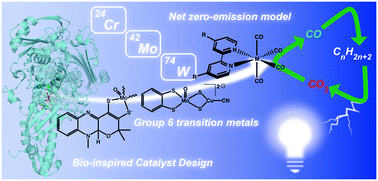Group 6 transition metal-based molecular complexes for sustainable catalytic CO2 activation
Abstract
The alarming growth in atmospheric CO2 has emerged as one of the prime concerns in the context of climate change. Power, petroleum, and construction sectors are the major contributors to CO2 emissions worldwide. The global imbalance of the present-day carbon cycle must be rectified for sustainable energy harvesting with modifications in existing CO2 capture, utilization, and sequestration (CCUS) methodologies. A rational link between hydrocarbon/CO2 and the water/H2 cycles can pave the way for a model net zero-emission energy infrastructure. The success of this net zero-emission energy scheme depends on the successful deployment of CO2 reduction reaction (CO2RR) and H2 evolution reaction (HER) catalysts that can be operated under broad chemical conditions in aqueous solutions. The associated thermodynamic factors have posed serious challenges for the scientific community to develop sustainable and economically viable catalysts for CO2RR. In this perspective, we have specifically essayed the generation of different variants of CO2 activating molecular catalysts based on group 6 transition elements [chromium (Cr), molybdenum (Mo), and tungsten (W)]. Their high natural abundance coupled with access to a wide range of redox states have poised these elements for utilization in the multielectron CO2RR process. These elements have also found their usage in biology in versatile oxidoreductase enzymes' active sites, including CO2 activating ones. The blueprint of such enzymes has prompted the inception of several molecular catalysts for CO2 activation following both chemical and electrochemical pathways. Close control of the ligand environment around these complexes was found crucial for the catalytic efficiency and product specificity. Despite these initial successes, group 6 transition metal-based molecular electrocatalysts are yet to match the remarkable catalytic efficiency of natural CO2 reduction enzymes. The rational incorporation of enzyme-inspired outer coordination sphere features (interactive peripheral functionalities) around the synthetic core can improve the catalytic response of Cr/Mo/W-based complexes further by assisting CO2 binding, creating a proton relay, and inducing superior water solubility. Hence, the enzyme-inspired catalyst design will possibly provide a new leeway in developing sustainable CO2RR catalysts, where the best of the metalloenzyme and organometallic complex can be brought together.

- This article is part of the themed collection: 10th Anniversary Perspectives


 Please wait while we load your content...
Please wait while we load your content...